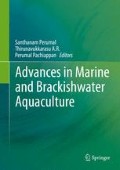Abstract
The marine aquarium trade is a billion dollar business that may sustain continued growth in the coming years. In the past decade, there has been a worldwide increase in the popularity of reef tanks, which has led to an increased demand for marine ornamental organisms (Wood 2001; Green 2003). In contrast to the freshwater ornamental species, most marine organisms being marketed in the aquarium trade are collected from the wild, particularly from coral reef areas. The prevalence of destructive low-cost harvesting techniques, such as the use of cyanide and explosives, has caused dramatic and drastic impacts on the health and biodiversity of the reef ecosystems. Developing hatchery technology for marine ornamental species is therefore urgently needed to guarantee the sustainable supply for the industry while minimising the negative impacts on the natural environment (Lin et al. 2002). In the recent years, researchers, traders, collectors and hobbyists have begun a worldwide effort to minimise the growing pressure on the natural populations of marine ornamental species and to promote the sustainable use of these high-valued resources (Corbin 2001).
Access this chapter
Tax calculation will be finalised at checkout
Purchases are for personal use only
References
Ajith Kumar TT, Balasubramanian T (2009) Broodstock development, spawning and larval rearing of the false clown fish, Amphiprion ocellaris in captivity using estuarine water. Curr Sci 97(10):1483–1486
Ajith Kumar TT, Sethu SK, Murugesan P, Balasubramanian T (2010) Studies on captive breeding and larval rearing of clownfish Amphiprion sebae (Bleeker, 1835) using estuarine water. Indian J Mar Sci 39(1):114–119
Corbin JS (2001) Marine Ornamentals’99, conference highlights and priority recommendations. In: Burgess P (ed) Marine ornamental conference, Kluwer Academic Publishers, Netherlands, Hawaii. Aqua Sci Conserv 3:3–11
Dey VK (2010) Ornamental fish trade – recent trends in Asia. In: Souvenir, ornamentals Kerala 2010. Department of Fisheries, Government of Kerala. pp 39–45
FAO (2009) Fish Stat Plus. Universal software for fishery statistical time series. Version 2.3. www.fao.org
Gopakumar G, Sreeraj G, Ajith Kumar TT, Sukumaran TN, Raju B, Unnikrishnan C, Hillary P, Benziger VP (2002) Breeding and larval rearing of three species of damsel fishes (Family: Pomacentridae). Mar Fish Inform Serv T & E Ser 171:3–5
Green E (2003) International trade in marine aquarium species: using the global marine aquarium database. In: Cato JC, Brown CL (eds) Marine ornamental species: collection, culture and conservation. Iowa State Press, Ames, pp 31–47
Lin J, Zhang D, Creswell R (2001) Aquaculture of marine ornamental shrimps: an overview. Aquaculture 2001 book of abstracts. World Aquaculture Society, Orlando, p 378
Lin J, Zhang D, Rhyne A (2002) Broodstock and larval nutrition of marine ornamental shrimp. In: Cruz-Suárez LE, Ricque-Marie D, Tapia-Salazar M, Gaxiola-Cortés MG, Simoes N (eds) Avances en Nutrición Acuícola VI. Memorias del VI Simposium Internacional de Nutrición Acuícola. 3 al 6 de Septiembre del 2002. Cancún, Quintana Roo, México, pp 589
Michael S (1996) The Banggai Cardinalfish: a newly available species that may become too popular for its own good. Aquar Fish Mag 8(8):86–87
Ogawa T, Brown C (2001) Ornamental fish aquaculture and collection in Hawaii. Aquar Sci Conserv 3(1–3):151–169
Olivier K (2003) World trade in ornamental species. In: Cato J, Brown C (eds) Marine ornamental species: collection, culture and conservation. Iowa State Press, Ames, pp 49–63
Setu SK, Ajith Kumar TT (2010) Spawning behaviour and Embryonic development of Regal damsel fish, Neopomacentrus cyanomus (Bleeker, 1856). World J Fish Mar Sci 2(5):410–415
Sprung J (2001) Oceanographic series invertebrates:, a quick reference guide. Ricordea Publishing, Miami, 240 pp
Tullock J (1999) Banggai cardinalfish alert. Aquar Front. http://www.aquariumfrontiers.net/EnvironmentalAquarist/html
Wabnitz C, Taylor M, Green E, Razak T (2003) From ocean to aquarium. UNEP-WCMC, Cambridge, p 64
Wood EM (2001) Collection of coral reef fish for aquaria: global trade, conservation issues and management strategies. Marine Conservation Society, UK, 80 pp
Author information
Authors and Affiliations
Corresponding author
Editor information
Editors and Affiliations
Rights and permissions
Copyright information
© 2015 Springer India
About this chapter
Cite this chapter
Kumar, T.T.A., Gunasundari, V., Prakash, S. (2015). Breeding and Rearing of Marine Ornamentals. In: Perumal, S., A.R., T., Pachiappan, P. (eds) Advances in Marine and Brackishwater Aquaculture. Springer, New Delhi. https://doi.org/10.1007/978-81-322-2271-2_11
Download citation
DOI: https://doi.org/10.1007/978-81-322-2271-2_11
Publisher Name: Springer, New Delhi
Print ISBN: 978-81-322-2270-5
Online ISBN: 978-81-322-2271-2
eBook Packages: Biomedical and Life SciencesBiomedical and Life Sciences (R0)

